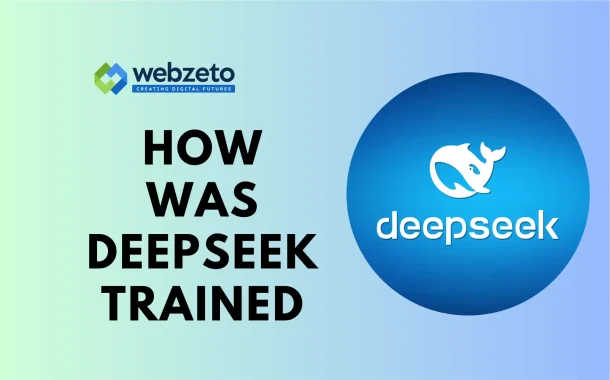The way DeepSeek was trained is important for its success. The training process involved using powerful computers and smart techniques to improve its performance. Methods like reinforcement learning and fine-tuning helped it become more precise and adaptable. These techniques allow DeepSeek to handle complex questions and generate high-quality text.
Table of Contents
Table of Contents
Foundational Models and Architectures
Strong Foundation and Development
DeepSeek is built on advanced AI models designed to understand and generate human-like text. It started with a strong base model trained on large datasets, allowing it to recognize patterns, meanings, and context. Over time, newer versions were developed, making DeepSeek more accurate and capable. These improvements help the model handle complex tasks, making it useful in various fields like research, business, and programming.
Transformer-Based Architecture
The core architecture of DeepSeek is based on transformers, a modern AI structure that processes vast amounts of information efficiently. Transformers allow the model to generate text quickly while maintaining accuracy. They use multiple layers to analyze and understand language, improving how AI responds to different inputs. This structure is widely used in advanced AI models due to its speed and effectiveness.
Advanced Training Techniques
DeepSeek also uses specialized techniques to enhance its performance. One important method is the Mixture-of-Experts (MoE), which divides tasks among different AI experts to improve efficiency. Another key technique is Multi-head Latent Attention (MLA), which helps the model focus on different parts of the input, leading to better results. These approaches make DeepSeek more powerful and adaptable in handling a variety of tasks.
Reliable and Effective AI Tool
By combining a strong foundation with advanced architectures, DeepSeek delivers high-quality responses with improved accuracy. Its design ensures that it can learn, adapt, and refine its understanding over time. This makes it a reliable and effective AI tool for generating text, solving problems, and assisting in different professional fields.
Training Data and Preprocessing
Large and Diverse Training Data
DeepSeek was trained using a vast collection of text data from different sources. This includes books, articles, websites, and research papers. Using a diverse dataset helps the model understand various writing styles, topics, and contexts. The goal is to make DeepSeek capable of generating accurate and meaningful responses in different situations. The quality and variety of data play a crucial role in improving the model’s performance.
Data Cleaning and Filtering
Before training, the data goes through a strict cleaning process. This step removes errors, duplicate content, and irrelevant information. Filtering ensures that only high-quality text is used, reducing biases and improving accuracy. The model is also trained to recognize and avoid harmful or misleading content. These preprocessing steps help DeepSeek generate better and more reliable outputs.
Text Tokenization and Structuring
To process text efficiently, DeepSeek converts words into smaller units called tokens. Tokenization helps the model break down sentences into manageable parts for better understanding. It also structures the text so the model can analyze relationships between words and phrases. This step is essential for improving language comprehension and generating coherent responses.
Innovative Training Techniques
Reinforcement Learning for Better Performance
DeepSeek uses reinforcement learning to improve its accuracy and adaptability. This technique allows the model to learn from feedback by adjusting its responses based on what works best. The model goes through multiple training rounds, refining its understanding with each step. This helps DeepSeek generate more precise and human-like text over time.
Mixture-of-Experts (MoE) for Efficiency
One of the key innovations in DeepSeek’s training is the Mixture-of-Experts (MoE) technique. Instead of relying on a single model for all tasks, MoE divides work among multiple AI experts. Each expert focuses on specific areas, making the model more efficient and accurate. This method improves DeepSeek’s ability to handle complex queries while optimizing processing power.
Multi-Head Latent Attention (MLA) for Better Understanding
DeepSeek also uses Multi-Head Latent Attention (MLA) to enhance its text processing. This technique allows the model to focus on multiple parts of a sentence at the same time. By analyzing different words and phrases together, DeepSeek improves its language comprehension. This helps it generate more relevant and context-aware responses.
Resource Optimization Strategies
Efficient Hardware Utilization
DeepSeek uses high-performance hardware, including powerful GPUs and TPUs, to handle large-scale training. These processors allow the model to process vast amounts of data quickly and efficiently. Distributed computing is also used, where multiple machines work together to speed up training. This ensures that DeepSeek can learn from massive datasets without unnecessary delays.
Cost-Effective Training Methods
Training an AI model requires significant resources, but DeepSeek optimizes costs by using advanced techniques. It applies mixed-precision training, which reduces memory usage without affecting performance. This method allows the model to process more data while using fewer resources. Additionally, dynamic batching ensures that the model trains efficiently by grouping similar tasks together, improving speed and reducing computation costs.
Smart Data Selection and Processing
Instead of training on all available data, DeepSeek uses selective training. This means it focuses on high-quality and diverse datasets while filtering out unnecessary information. This approach reduces the amount of data processed, saving both time and energy. By prioritizing useful data, the model improves efficiency without compromising accuracy.
Fine-Tuning and Specialization
Improving Accuracy with Fine-Tuning
DeepSeek undergoes fine-tuning to improve its performance on specific tasks. This process involves training the model on specialized datasets, helping it generate more precise and context-aware responses. Fine-tuning ensures that DeepSeek can adapt to different industries, including research, business, and technology. By refining its knowledge, the model becomes more reliable and efficient in real-world applications.
Domain-Specific Training
To enhance specialization, DeepSeek is trained on domain-specific data. This allows it to understand industry-related language, terminology, and unique requirements. For example, in medical research, it can process complex medical terms accurately. Similarly, in finance, it can analyze market trends effectively. This targeted training makes DeepSeek more valuable for professionals needing specialized AI support.
Customization for Different Use Cases
DeepSeek’s architecture allows for custom adjustments based on user needs. Businesses and developers can fine-tune the model to align with their specific goals. Whether it’s improving chatbot interactions, automating content generation, or analyzing large datasets, DeepSeek can be adapted for various purposes. This flexibility makes it a powerful tool across different fields.
Conclusion
DeepSeek was trained using advanced AI techniques, large datasets, and efficient processing methods. It uses transformers, reinforcement learning, and specialized training to improve accuracy and performance. Techniques like Mixture-of-Experts and Multi-Head Latent Attention help it handle complex tasks effectively.
With fine-tuning and resource optimization, DeepSeek becomes more precise and adaptable. It can specialize in different fields and improve over time. Its efficient training methods make it a powerful and reliable AI tool.














